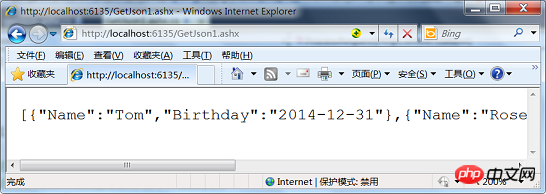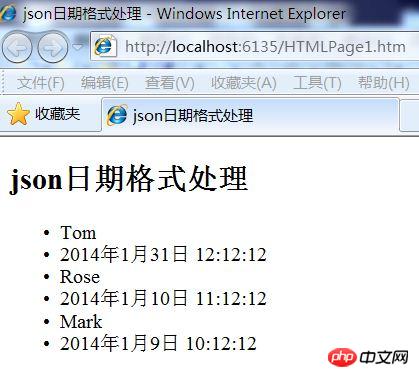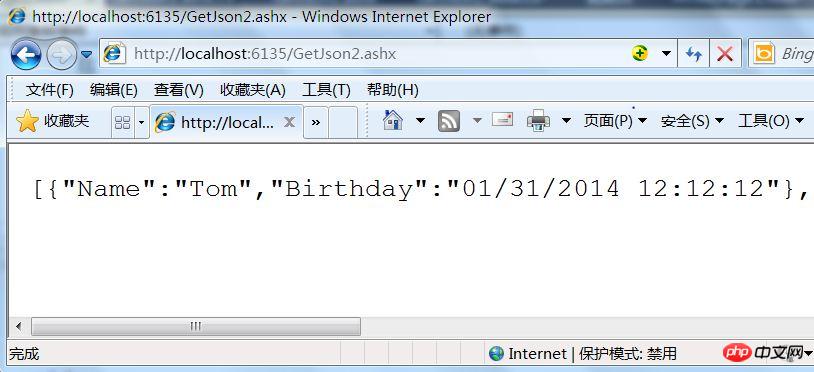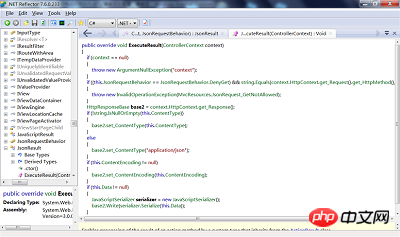
This time I will bring you the Json operation date format. What are the precautions for Json operation date format? . The following is a practical case, let’s take a look.
During development, sometimes it is necessary to return data in json format from the server. If there is DateTime type data in the background code, it will be serialized using the system's own tool class and a long number will be obtained to represent the date data. , as shown below:
//设置服务器响应的结果为纯文本格式
context.Response.ContentType = "text/plain";
//学生对象集合
List<Student> students = new List<Student>
{
new Student(){Name ="Tom",
Birthday =Convert.ToDateTime("2014-01-31 12:12:12")},
new Student(){Name ="Rose",
Birthday =Convert.ToDateTime("2014-01-10 11:12:12")},
new Student(){Name ="Mark",
Birthday =Convert.ToDateTime("2014-01-09 10:12:12")}
};
//javascript序列化器
JavaScriptSerializer jss=new JavaScriptSerializer();
//序列化学生集合对象得到json字符
string studentsJson=jss.Serialize(students);
//将字符串响应到客户端
context.Response.Write(studentsJson);
context.Response.End();The running result is:

The corresponding birthday of Tom "2014-01-31" becomes 1391141532000 , this is actually the number of milliseconds from January 1, 1970 to the present; 1391141532000/1000/60/60/24/365=44.11 years, 44 1970=2014 years. According to this method, the year, month, day, hour, minute, second and millisecond can be obtained . This format is a feasible representation but not a friendly format that ordinary people can understand. How to change this format?
Solution:
Method 1: Use the Select method## for the date format on the server side #Or LINQ expression is converted and sent to the client:
using System;
using System.Collections.Generic;
using System.Web;
using System.Web.Script.Serialization;
namespace JsonDate1
{
using System.Linq;
/// <summary>
/// 学生类,测试用
/// </summary>
public class Student
{
/// <summary>
/// 姓名
/// </summary>
public String Name { get; set; }
/// <summary>
/// 生日
/// </summary>
public DateTime Birthday { get; set; }
}
/// <summary>
/// 返回学生集合的json字符
/// </summary>
public class GetJson : IHttpHandler
{
public void ProcessRequest(HttpContext context)
{
//设置服务器响应的结果为纯文本格式
context.Response.ContentType = "text/plain";
//学生对象集合
List<Student> students = new List<Student>
{
new Student(){Name ="Tom",Birthday =Convert.ToDateTime("2014-01-31 12:12:12")},
new Student(){Name ="Rose",Birthday =Convert.ToDateTime("2014-01-10 11:12:12")},
new Student(){Name ="Mark",Birthday =Convert.ToDateTime("2014-01-09 10:12:12")}
};
//使用Select方法重新投影对象集合将Birthday属性转换成一个新的属性
//注意属性变化后要重新命名,并立即执行
var studentSet =
students.Select
(
p => new { p.Name, Birthday = p.Birthday.ToString("yyyy-mm-dd") }
).ToList();
//javascript序列化器
JavaScriptSerializer jss = new JavaScriptSerializer();
//序列化学生集合对象得到json字符
string studentsJson = jss.Serialize(studentSet);
//将字符串响应到客户端
context.Response.Write(studentsJson);
context.Response.End();
}
public bool IsReusable
{
get
{
return false;
}
}
}
}
Method 2:
Convert the string in "Birthday":"\/Date(1391141532000)\/" into a date object in javascript , you can delete the non-numeric characters in the Value corresponding to the Birthday Key by replacing them to a number 1391141532000, and then instantiate a Date object, using 1391141532000 milliseconds as a parameter to get a date object in javascript, the code is as follows :<!DOCTYPE html>
<html xmlns="http://www.w3.org/1999/xhtml">
<head>
<title>json日期格式处理</title>
<script src="Scripts/jquery-1.10.2.min.js" type="text/javascript"></script>
<script type="text/javascript">
$(function() {
$.getJSON("getJson.ashx", function (students) {
$.each(students, function (index, obj) {
$("<li/>").html(obj.Name).appendTo("#ulStudents");
//使用正则表达式将生日属性中的非数字(\D)删除
//并把得到的毫秒数转换成数字类型
var birthdayMilliseconds = parseInt(obj.Birthday.replace(/\D/igm, ""));
//实例化一个新的日期格式,使用1970 年 1 月 1 日至今的毫秒数为参数
var birthday = new Date(birthdayMilliseconds);
$("<li/>").html(birthday.toLocaleString()).appendTo("#ulStudents"); ;
});
});
});
</script>
</head>
<body>
<h2>json日期格式处理</h2>
<ul id="ulStudents">
</ul>
</body>
</html>
$(function () {
$.getJSON("getJson.ashx", function (students) {
$.each(students, function (index, obj) {
$("<li/>").html(obj.Name).appendTo("#ulStudents");
//使用正则表达式将生日属性中的非数字(\D)删除
//并把得到的毫秒数转换成数字类型
var birthdayMilliseconds = parseInt(obj.Birthday.replace(/\D/igm, ""));
//实例化一个新的日期格式,使用1970 年 1 月 1 日至今的毫秒数为参数
var birthday = new Date(birthdayMilliseconds);
$("<li/>").html(birthday.toLocaleString()).appendTo("#ulStudents");
$("<li/>").html(obj.Birthday.toDate()).appendTo("#ulStudents");
});
});
});
//在String对象中扩展一个toDate方法,可以根据要求完善
String.prototype.toDate = function () {
var dateMilliseconds;
if (isNaN(this)) {
//使用正则表达式将日期属性中的非数字(\D)删除
dateMilliseconds =this.replace(/\D/igm, "");
} else {
dateMilliseconds=this;
}
//实例化一个新的日期格式,使用1970 年 1 月 1 日至今的毫秒数为参数
return new Date(parseInt(dateMilliseconds));
};Method 3:
You can choose some third-party json tool classes, many of which have already dealt with date format issues, commonjson serialization and deserialization tool libraries are:
1.fastJSON.2.JSON_checker.
3.Jayrock.
4.Json.NET - LINQ to JSON.
5.LitJSON.
6.JSON for .NET.
7.JsonFx.
8.JSONSharp.
9.JsonExSerializer.
10.fluent-json
11.Manatee Json
using System;
using System.Collections.Generic;
using System.Web;
using LitJson;
namespace JsonDate2
{
using System.Linq;
/// <summary>
/// 学生类,测试用
/// </summary>
public class Student
{
/// <summary>
/// 姓名
/// </summary>
public String Name { get; set; }
/// <summary>
/// 生日
/// </summary>
public DateTime Birthday { get; set; }
}
/// <summary>
/// 返回学生集合的json字符
/// </summary>
public class GetJson : IHttpHandler
{
public void ProcessRequest(HttpContext context)
{
//设置服务器响应的结果为纯文本格式
context.Response.ContentType = "text/plain";
//学生对象集合
List<Student> students = new List<Student>
{
new Student(){Name ="Tom",Birthday =Convert.ToDateTime("2014-01-31 12:12:12")},
new Student(){Name ="Rose",Birthday =Convert.ToDateTime("2014-01-10 11:12:12")},
new Student(){Name ="Mark",Birthday =Convert.ToDateTime("2014-01-09 10:12:12")}
};
//序列化学生集合对象得到json字符
string studentsJson = JsonMapper.ToJson(students);
//将字符串响应到客户端
context.Response.Write(studentsJson);
context.Response.End();
}
public bool IsReusable
{
get
{
return false;
}
}
}
}
var date = new Date("01/31/2014 12:12:12");
alert(date.toLocaleString());$(function () {
$.getJSON("GetJson2.ashx", function (students) {
$.each(students, function (index, obj) {
$("<li/>").html(obj.Name).appendTo("#ulStudents");
var birthday = new Date(obj.Birthday);
$("<li/>").html(birthday.toLocaleString()).appendTo("#ulStudents");
});
});
});
var date = new Date("01/31/2014 12:12:12");
alert(date.toLocaleString());Method 4:
This text was posted on the blog and netizens put forward their valuable opinions. I did not consider the situation in MVC. In fact, handlers can also be used in MVC, so the difference is not It’s very big, but there is an Action in MVC specifically for server response to JSON. The code is as follows:using System;
using System.Web.Mvc;
namespace JSONDateMVC.Controllers
{
public class HomeController : Controller
{
public JsonResult GetJson1()
{
//序列化当前日期与时间对象,并允许客户端Get请求
return Json(DateTime.Now, JsonRequestBehavior.AllowGet);
}
}
}下载一个内容为Application/json的文件,文件名为GetJson1,内容是"\/Date(1391418272884)\/"
从上面的情况看来MVC中序列化时并未对日期格式特别处理,我们可以反编译看源码:
Return调用的Json方法:
protected internal JsonResult Json(object data, JsonRequestBehavior behavior)
{
return this.Json(data, null, null, behavior);
}
this.Json方法
protected internal virtual JsonResult Json(object data, string contentType, Encoding contentEncoding, JsonRequestBehavior behavior)
{
return new JsonResult { Data = data, ContentType = contentType, ContentEncoding = contentEncoding, JsonRequestBehavior = behavior };
}JsonResult类ActionResult类的子类,ExecuteResult方法:

从上面的代码中不难看出微软的JsonResult类仍然是使用了JavaScriptSerializer,所以返回的结果与方法一未处理时是一样的,要解决这个问题我们可以派生出一个新的类,重写ExecuteResult方法,使用Json.net来完成序列化工作,JsonResultPro.cs文件的代码如下:
namespace JSONDateMVC.Common
{
using System;
using System.Web;
using System.Web.Mvc;
using Newtonsoft.Json;
using Newtonsoft.Json.Converters;
public class JsonResultPro : JsonResult
{
public JsonResultPro(){}
public JsonResultPro(object data, JsonRequestBehavior behavior)
{
base.Data = data;
base.JsonRequestBehavior = behavior;
this.DateTimeFormat = "yyyy-MM-dd hh:mm:ss";
}
public JsonResultPro(object data, String dateTimeFormat)
{
base.Data = data;
base.JsonRequestBehavior = JsonRequestBehavior.AllowGet;
this.DateTimeFormat = dateTimeFormat;
}
/// <summary>
/// 日期格式
/// </summary>
public string DateTimeFormat{ get; set; }
public override void ExecuteResult(ControllerContext context)
{
if (context == null)
{
throw new ArgumentNullException("context");
}
if ((this.JsonRequestBehavior == JsonRequestBehavior.DenyGet) && string.Equals(context.HttpContext.Request.HttpMethod, "GET", StringComparison.OrdinalIgnoreCase))
{
throw new InvalidOperationException("MvcResources.JsonRequest_GetNotAllowed");
}
HttpResponseBase base2 = context.HttpContext.Response;
if (!string.IsNullOrEmpty(this.ContentType))
{
base2.ContentType = this.ContentType;
}
else
{
base2.ContentType = "application/json";
}
if (this.ContentEncoding != null)
{
base2.ContentEncoding = this.ContentEncoding;
}
if (this.Data != null)
{
//转换System.DateTime的日期格式到 ISO 8601日期格式
//ISO 8601 (如2008-04-12T12:53Z)
IsoDateTimeConverter isoDateTimeConverter=new IsoDateTimeConverter();
//设置日期格式
isoDateTimeConverter.DateTimeFormat = DateTimeFormat;
//序列化
String jsonResult = JsonConvert.SerializeObject(this.Data,isoDateTimeConverter);
//相应结果
base2.Write(jsonResult);
}
}
}
}使用上面的JsonResultPro Action类型的代码如下:
public JsonResultPro GetJson2()
{
//序列化当前日期与时间对象,并允许客户端Get请求,注意H是大写
return new JsonResultPro(DateTime.Now,"yyyy-MM-dd HH:mm");
}相信看了本文案例你已经掌握了方法,更多精彩请关注php中文网其它相关文章!
推荐阅读:
The above is the detailed content of Json operation date format. For more information, please follow other related articles on the PHP Chinese website!




